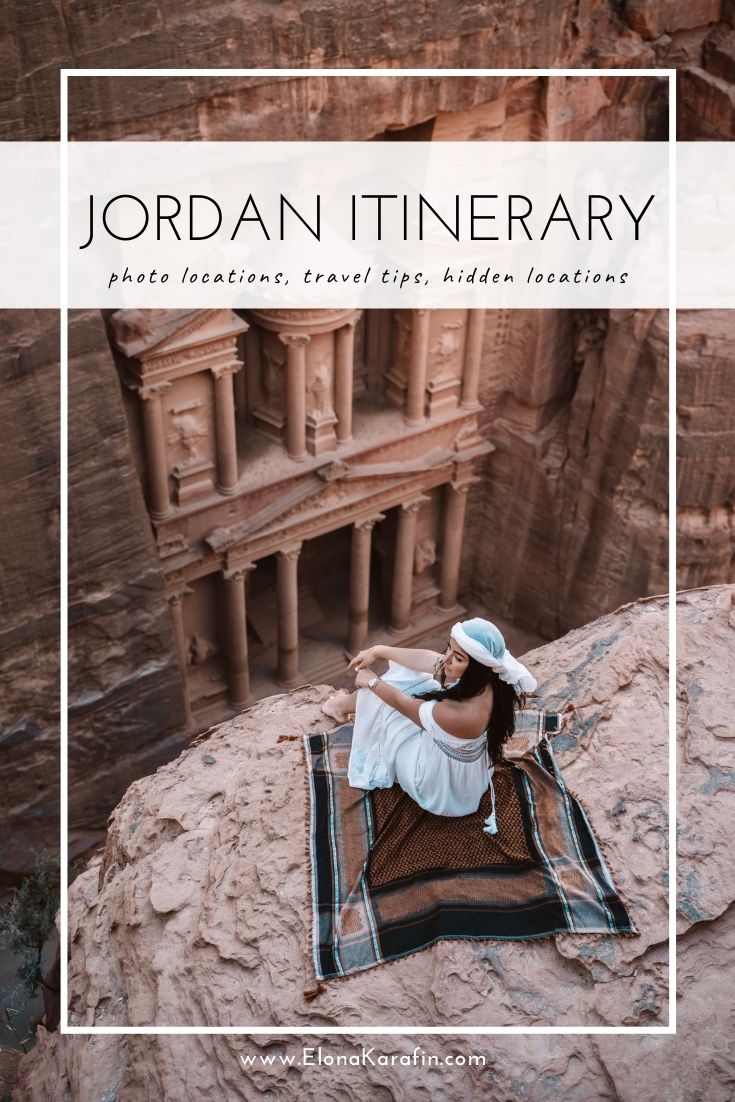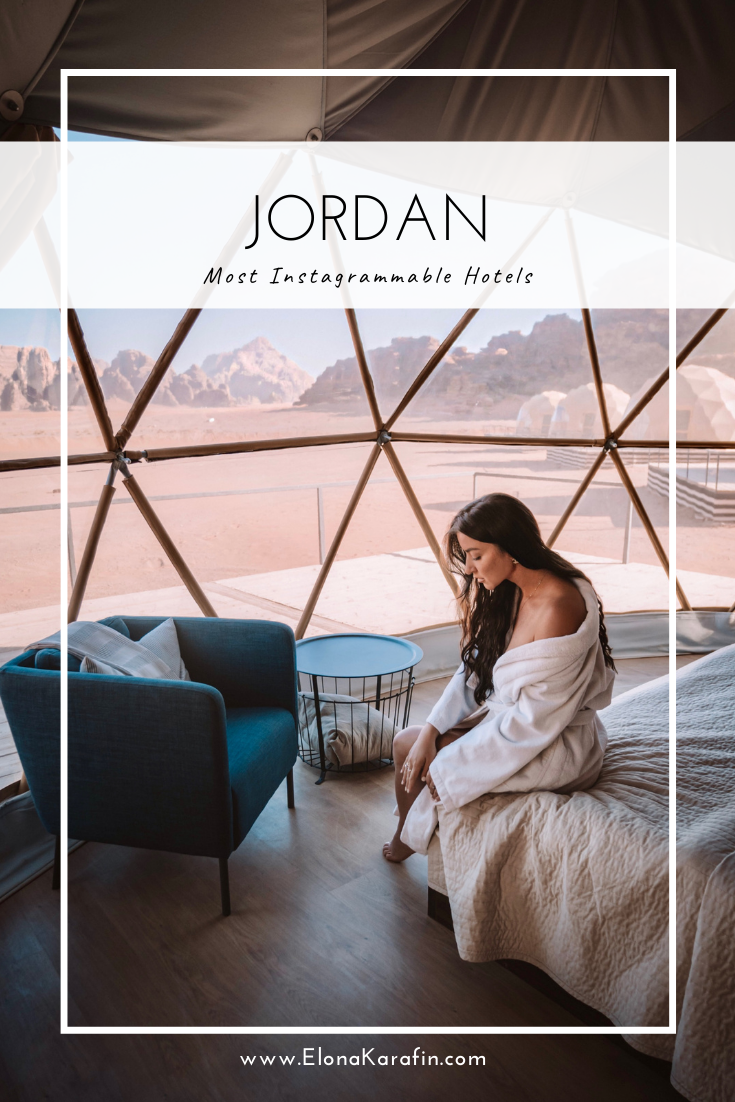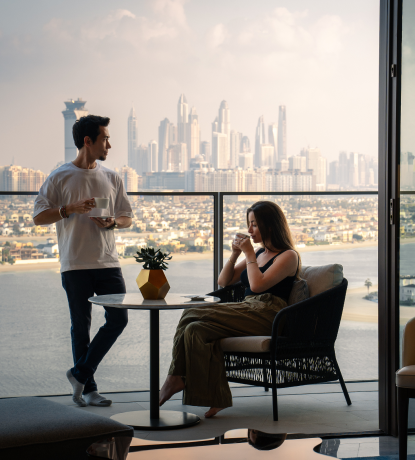Contents
I can’t believe it took me such a long time to visit Jordan. In the last 4 years, I’ve traveled extensively around the Middle East, often being in the region 4 – 5 times a year. For no particular reason, I didn’t make it to Jordan. That is until a few weeks ago when I made [easily] one of the best travel decisions in the slowly reopening, post-pandemic world. Jordan ticks off many of my non-negotiables for a perfect trip, which include, but are not limited to: HOSPITALITY (intentionally capitalized), relatively easy to navigate, safe, scenic, diverse, unique properties and experiences, affordable, ability to both relax or to have a busy, fast-paced itinerary.
This point contains affiliate links from which, at no extra cost to you, I may earn a small commission.
I traveled to Jordan with my good friend and talented photographer Jerome. The beautiful pictures below were taken by him. Make sure to give him a follow!
Jordan Itinerary at a Glance
Amman: 3 nights
- Where to stay? Four Seasons Hotel
- Where to eat? La Capitale (upscale), Hashem (street food), The Living Room Loft (trendy rooftop), Wild Jordan Cafe (panoramic city views)
- What to see? Amman Citadel, King Abdullah I Mosque, Jabal Al Weibdeh
Petra: 2 nights
- Where to stay? Petra Luxe Bubble Hotel, Seven Wonders Bedouin Camp
- What to see? Petra Treasury vantage point, Petra Monastery [long] hike, Little Petra
Wadi Rum: 3 nights
- Where to stay? Wadi Rum Luxe Bubble Hotel, Sun City Camp
- What to see? Scenic drive with local bedouin, French Castle, “Big Arch”
Aqaba: 1 night (optional)
- Where to stay? Cloud 7 Ayla Oasis
Dead Sea: 1 night (optional)
Entry Requirements for Jordan
(updated July 10th, 2021)
At the time of our trip in June 2021, a negative PCR test done within 72 hours was required to enter Jordan. Likewise, travelers have to fill out a form, with basic information including vaccination status. Unvaccinated travelers pre-pay an on-arrival COVID test while vaccinated travelers are exempt from this test. There is also a requirement for a visa on arrival, depending on where you fly in from. Travel restrictions change daily so please make sure you check the official Jordanian website or your local embassy website for the most up-to-date information on traveling from your country of origin. Likewise, traveling is a personal decision and if you choose to do so, please follow all the rules to keep yourself and others safe.
Getting to Jordan
(updated July 10th, 2021)
Royal Jordanian business class is a fantastic option to fly to the capital of Jordan: Amman. My hub is JFK in New York City, from which Royal Jordanian currently flies 4 times a week. The outbound flight departs at night out of Terminal 8 and arrives midday in Amman, which allows you to get some rest in-flight and also to have a reasonable amount of time in the Capital on your first day. The Boeing 787 Dreamliner is the newest to RJ’s fleet. If you’ve been following me on Instagram, you know that I love the Dreamliner – it is a beautiful, spacious aircraft designed to help you rest and minimize jetlag. The business class cabin has 24 seats arranged in a 2-2-2 configuration. The seats are lie-flat, comfortable, and spacious measured at 78 inches long and 21 inches wide (SeatGuru).
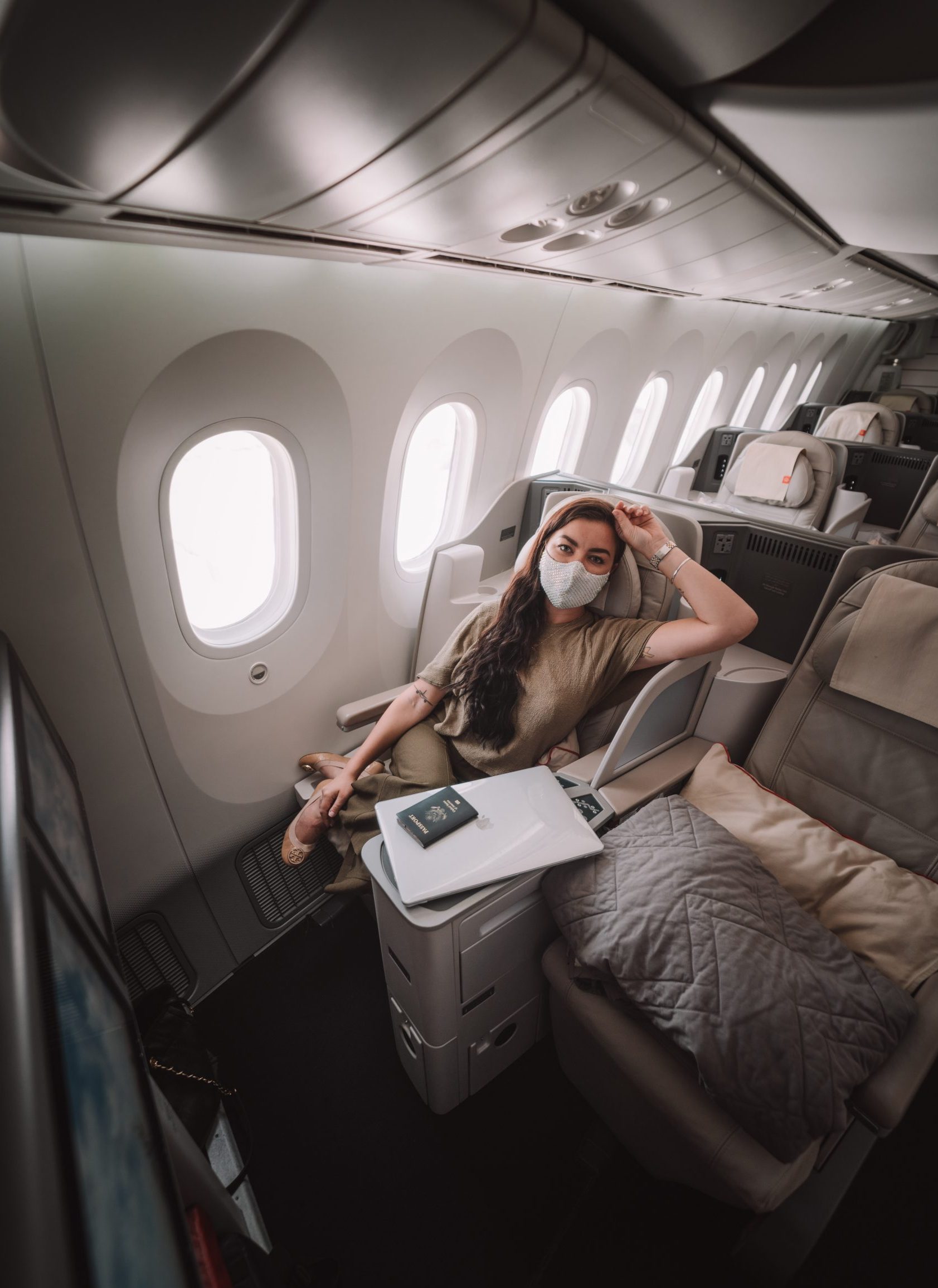
By the natural Jordanian way of hospitality, we were greeted by an incredible cabin crew that offered us Arabic coffee before we even sat down! You will find this kind of warmth and kindness virtually everywhere in Jordan and it’s quite nice to start your trip like this! I believe that a trip starts in the airplane cabin … and the welcome we received from Royal Jordanian is exactly why I feel this way.
The IFE monitor is 17″ with many entertainment choices. I wanted to note that on the aircraft that don’t have TVs, RJ launched the new and improved streaming service of Sky Connect. You can connect via SkyConnect WiFi on board and stream their collection of entertainment on any device. As much as I enjoyed my flight to Amman, the Crown Lounge experience prior to my return leg was where the fun truly began! First of all the Crown Lounge is huge and it wraps around a large chunk of the second floor of Queen Alia Airport.
After going through the [separate] business class terminal where security and passport control was practically seamless, I took the elevator up to the Crown Lounge. The first thing I got was a traditional Jordanian breakfast and a latte (which, to my excitement, had my face printed on it!). The lounge has a pizza bar (& an alcohol bar), a coffee shop, an ice cream machine, a huge buffet, and a dessert table – just to name a few. To be honest, it is one of the most impressive airport lounges I’ve been to in terms of the offering. There is also a quiet area, a library, and showers readily available.
Best Jordan Flight + Hotel Prices
Jordan’s Capital City Amman
Amman is one of the oldest cities in the world! Excavations show homes that are believed to be built during the Stone Age and there are many Biblical references to the city, too. Amman is charming in every sense of the word. If you look at it from a birds-eye view, the homes seem stacked on top of each other like a lego-set of neutral tones. We spent a total of 3 nights in the Capital city and it may be worth staying longer as there are a few day trips you can take (ie. Mount Nebo, As-Salt, Wadi Mujib). If your time in Amman is limited, some of the things you must see are the Citadel, Abdullah I Mosque, Jabal Al Weibdeh neighborhood, and you must try what is known as the best falafel at Hashem. I must give you a fair warning: if you are renting a car, driving in Amman is not for the faint-hearted! There are pretty much no rules and the markings on the roads are merely there as reference points. It is chaotic and exciting at the same time.

The Amman Citadel is located on the highest of seven hills on which the city was built. This area, which dates back all the way to the Bronze Age, was occupied by the Romans, Byzantine, Persians, and Greeks and the Temple of Hercules is arguably the most significant Roman structure in the Amman Citadel. It’s quite unreal to me that these historic sites are so bare and fully open to the public. You’ll see kids climbing on the stone structures … and couples playing games at the base of the temple. The Citadel also has sweeping panoramic views of Amman. The second place with a nice vantage point over the city is the Wild Jordan Cafe.
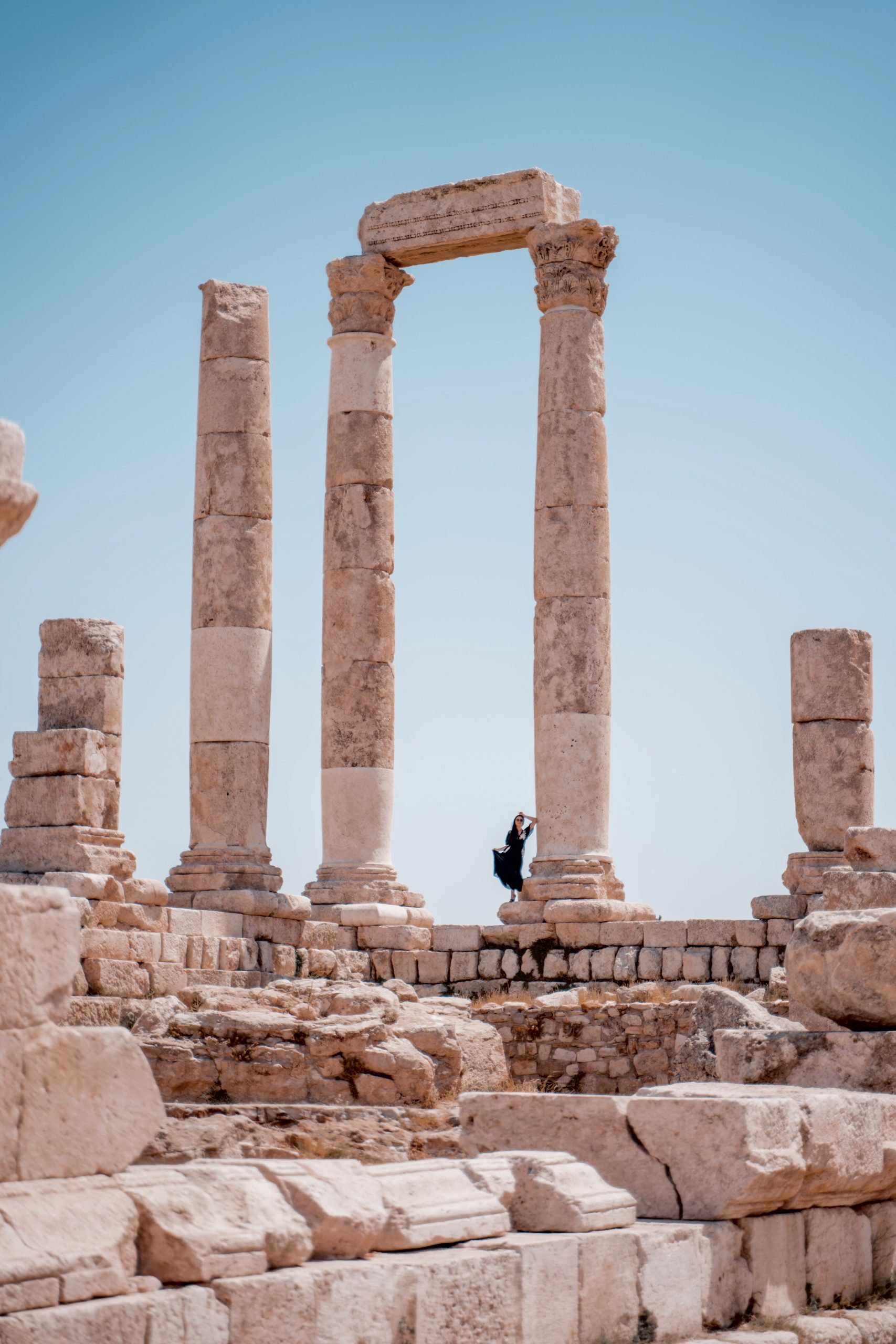
Practical Information about Petra, Jordan
Roughly three hours south of Amman by car is Petra, The former Capital of Nabataea. The Nabateans were one of the most powerful and wealthiest tribes in the Arabian Peninsula! Most were very skilled traders – their trade routes extend to China, India, Egypt, Greece, and more. Petra is also referred to as Rose City, due to the rosy pink sandstone where the remnants of one of the oldest cities in the world still exist today. The drive to Petra is simple and scenic but aside from the actual World Heritage Site, there isn’t much to do in the neighboring towns. In fact, even when driving into the area, we found ourselves following the signs through narrow streets within small villages. Basically, nothing you’d expect from a location that sees over a million tourists each year. That said, the welcome center and Petra itself are modern and built well for the comfort of visitors.
The number of days you should stay in Petra ultimately depends on how much of it you want to see and how much physical activity you are comfortable with. Petra is HUGE – there are over 800 tombs and some hikes can take up to 7 hours. Incredible to think that only ~15% of Petra has been explored by archaeologists.
Arguably the most popular part of Petra is known as the “Treasury” (although it is not a treasury at all, but rather a tomb). It is at the beginning of the city and about a 30-minute walk from the visitor center. There is more than one way to see the Treasury: you can enter Petra and simply walk to it, or you can pay a local guide to take you to a vantage point where you will see the Treasury from above. You absolutely must have a guide to go to the vantage point for safety reasons and because it is a hike off the beaten path. If you only have one day in Petra, I recommend doing the hike to one of the high vantage points (it’s very scenic) to see the Treasury from above and also on the ground level. The hike takes about an hour and there are only a few small areas where you need to climb.
Our guide’s name was Hossam and I highly recommend him if you want to see the high vantage point of the Treasury and in general to have someone show you the best locations! You can find him on Instagram here. Feel free to send him a message and let him know you found him through me  The photo below is from the high vantage point. There are two famous points and this one is the less popular one.
The photo below is from the high vantage point. There are two famous points and this one is the less popular one.
 The photo below is from the high vantage point. There are two famous points and this one is the less popular one.
The photo below is from the high vantage point. There are two famous points and this one is the less popular one.
The second most popular part of Petra is Ad Deir, الدير, Arabic for “The Monastery.” It is the name given to the colossal facade below by local bedouin’s, who found crosses inscribed on its interior walls. Ad Deir, like the Treasury, is actually a tomb (albeit an unfinished one). This “Monastery” is about a 1.5-hour hike each way which includes over 900 steps. The trail is actually very simple to follow and you can do it without a guide. By the Monastery there is a shop with souvenirs, coffee, snacks & more. Along the trail, there are also a plethora of little souvenir booths where you can meet local bedouins, share some tea and stories and support small businesses. On the way back you can take the same trail or there is another trail called “the back way” which local guides recommend because they claim it’s a shorter walk, and they can pick you up by car from the base. We found the hike to be a lot more rigorous through the back way and I definitely don’t recommend it especially in the heat. You will also have many locals offering you donkey rides on the trails. PLEASE DO NOT ride animals in Petra – they do these treks multiple times a day, in the heat & often with no breaks. It’s really disheartening to see and not worth it.
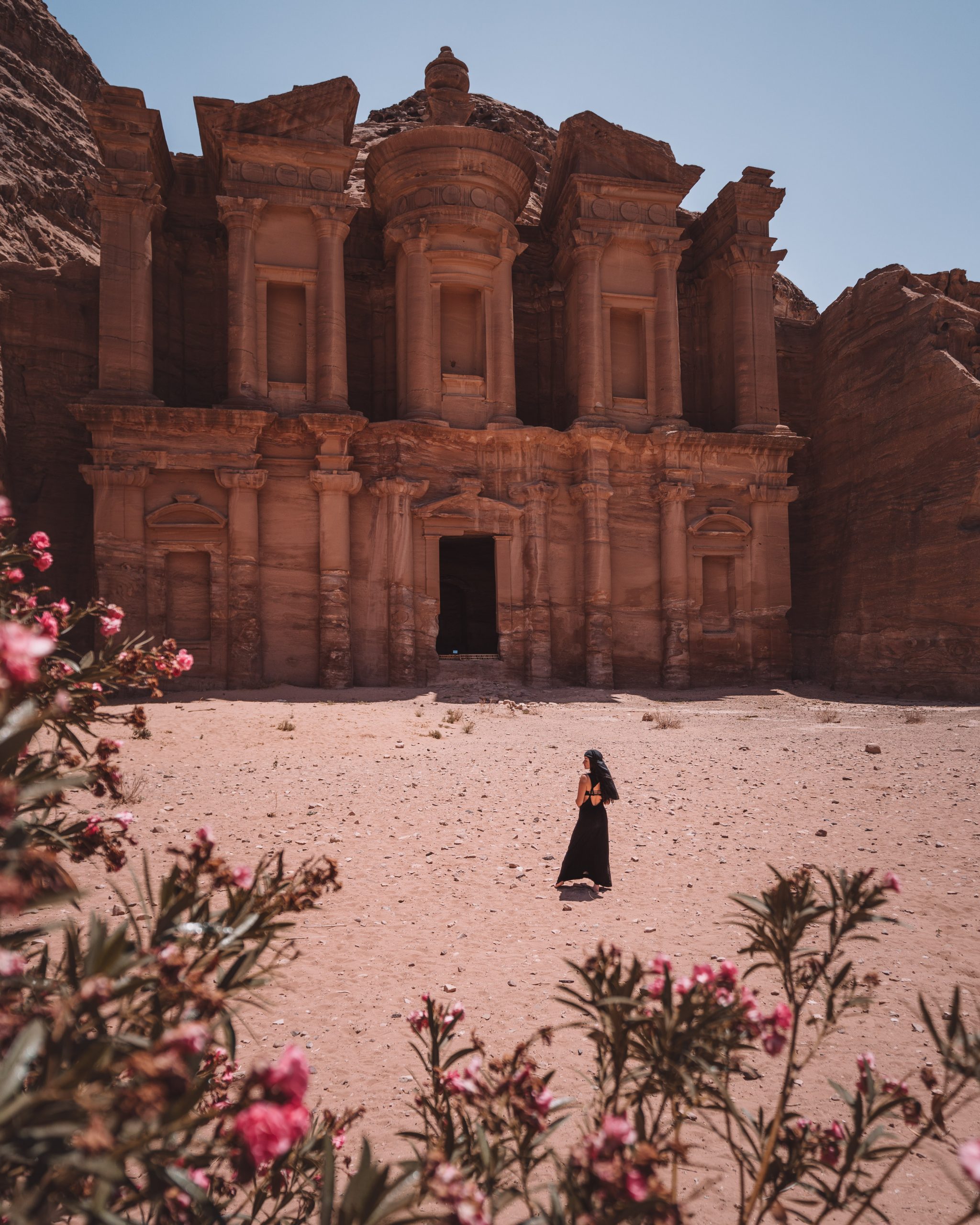
We spent 2 nights in Petra and I’d say the sweet spot is between 2-3 nights at least. We arrived early from Amman, checked into our hotel, and went to the vantage point of the Treasury in the second half of the day to get better light in phots. The next morning we arrived in Petra at the opening time of 6 AM, saw the Treasury EMPTY which was surreal and then we hiked to the Monastery. There are many more tombs and hikes you can see or do if you have more time. I found that 2 nights and 2.5 days was enough to see the most photogenic parts of Petra and to experience the properties.
Wadi Rum, Jordan: Practical Information
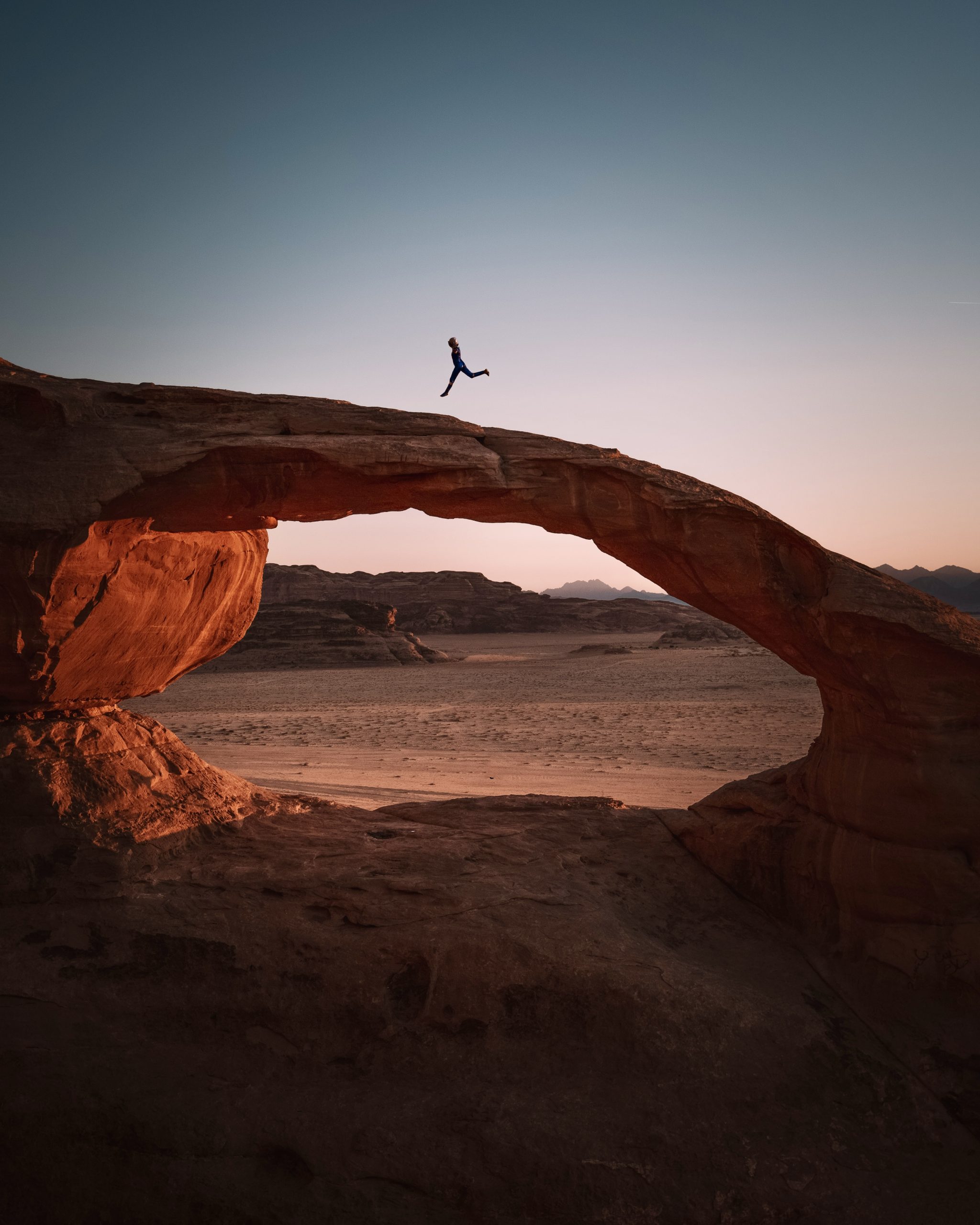
Wadi Rum is also known as Wadi al-Qamar,وادي القمر, Valley of the Moon. Why? Well because it quite literally looks like a different planet! The region has been featured in countless movies: The Martian, Red Planet, Star Wars – you can tell the common theme. Wadi Rum is home to the Zalabieh tribe – this tribe owns most of the accommodation, restaurants, and shops in the area. Members of this tribe are local guides who are highly experienced in the treks and have incomparable knowledge of the region. Wadi Rum is huge (roughly the size of NYC) – and different hotels (camps) are scattered all over the area. Since each property is owned or partially owned by locals, they also provide local guides for various tours. There is something for everyone: you can go mountain climbing, star gazing, seeing some of the most insane geological evolutions of the earth, looking at inscriptions from 12,000 years ago, experiencing a simple bedouin life, yoga, and so much more.

We stayed in Wadi Rum for three nights although we could’ve done it in two. Wadi Rum is a giant protected area and there are hotels, also called camps, both inside the protected area and right on the outskirts. There aren’t many differences between the protected area and the outskirts. I suppose the biggest difference is that many of the camps are so far into the protected area that it takes a lot of time to drive there (and you can only drive into the protected areas with a local guide or someone representing the hotel). We stayed in two hotels, both on the outskirts, and a local guide drove us around all the beautiful photo locations. The tours are around 4 hours long depending on how many spots you want to see. Since we had some free time in Wadi Rum where we didn’t do any activities (especially in the heat of the day), we drove an hour south to Aqaba.
Jordan’s Port City of Aqaba
Aqaba is Jordan’s beautiful [and only] port city located on the southern tip of the country about an hour away from Wadi Rum. It has a fascinating history as it was and still is the vital location for land and sea routes from Asia, Africa, and Europe. The city is administered by the Aqaba Special Economic Zone Authority, making Aqaba a low-tax, duty-free city, attracting several mega projects like Ayla – “a 4.3 million sqm waterfront destination, committed to environmental sustainability by protecting the integrity of its marine and wildlife, recycling its water resources and harnessing solar energy for power” (Ayla Website). Ayla is absolutely beautiful and if you saw it in a photo with no Geotag, surely you would think it is somewhere in Mykonos or Santorini. We didn’t have Aqaba on our itinerary as a place to stay because we weren’t looking for any relaxing beach days or city time aside from Amman. However, if you want to include a bit of relaxation, shopping, and dining – Aqaba should definitely be on your list! If you are staying in Wadi Rum for more than two nights, as we did, you can easily take a quick half-day trip to Aqaba to explore and have lunch. Many shops and restaurants are just starting to re-open and I can already imagine how booming the area will be when all the pandemic-related restrictions are fully lifted!

The Dead Sea, Jordan
As depressing as the name sounds, the Dead Sea can actually be a great time. The Dead Sea is hyper salty, making it nearly impossible to swim in … you can only float! On this trip, Jerome and I skipped staying near the Dead Sea because both of us have been in the past and we wanted to focus on photography and new places. However, if this is your first time in Jordan then the Dead Sea is something you can’t miss. If you enjoy relaxing, spas and massages – consider spending a night at the Kempinski Hotel Dead Sea, it is considered to be the best in the area. Otherwise, you can do a day trip to the Dead Sea from Amman (it is about a 45-minute ride by car), many hotels offer day passes so you get a full experience of the area.
Useful phrases to say in Arabic when speaking to locals in Jordan!
| English | Arabic | Response |
| Hello | marhaba | marhabtein |
| Greetings (peace be upon you) | as salaam aleikum | wa aleikum as salaam |
| Good morning | sabbah al kheir | sabbah an noor |
| Good evening | masaa al kheir | masaa an noor |
| How are you? | kif halak? (to a male) kif halik? (to a female) | tmaam (fine) al hamdulillah (formal) |
| What’s your name? | shu ismak? (to a male) ismik? (to a female) | |
| Pleased to meet you | tsharrafna | |
| I don’t understand Arabic | ma baref Arabi | |
| I don’t speak Arabic | ma bahki Arabi | |
| Do you speak English? | btihki ingileezi? | |
| Thank You | shukran | afwan (you’re welcome) |
| Yes | naam | |
| No | laa |
